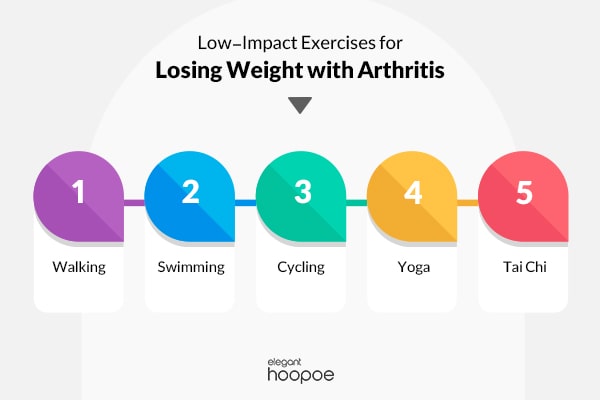Arthritis is a condition that causes inflammation and pain in the joints, leading to reduced mobility and difficulty in performing daily activities. while there are various treatments available, many individuals look to weight loss as a potential solution. But is weight loss really good for arthritis?
Research has shown that there is a strong link between excess weight and arthritis, particularly in the knees and hips. Carrying extra weight puts additional pressure on these joints, leading to increased wear and tear, which can exacerbate the symptoms of arthritis. Therefore, losing weight can help to reduce this pressure and alleviate pain and discomfort.
However, it’s important to note that weight loss is not a guaranteed cure for arthritis, and it may not work for everyone. Additionally, losing weight can be challenging and requires a combination of a healthy diet and regular exercise. Therefore, it’s essential to work with a healthcare provider to develop a safe and effective weight loss plan that takes into account any underlying health conditions or medications.
In this article on Elegant Hoopoe, we will explore losing weight with arthritis, the relationship between weight loss and arthritis in more detail, examining the benefits and potential challenges of losing weight to manage arthritis symptoms.
Effects of weight on the joints
Every single joint in the human body carries weight, some of them however carry the most amount of weight for instance knee joints, spinal joints and joints in the neck tend to carry the most weight in our body. Now even when an individual has normal BMI and a healthy weight, it is likely they are going to face some pain in these joints over time but for those who are overweight and obese, there are more complications that could happen and a common one is arthritis.

Just an extra ten pounds can put between 15 to 50 pounds more pressure on the knees. This is why most people with BMI higher than the healthy range tend to face OA arthritis as they age. But being overweight does more than just OA, it can also speed up the destruction of cartilage.
The more an individual weighs, the more damaged is their knee is going to face. For instance, the knee of an individual with healthy weight absorbs around 1.5 pounds for each step, Now if you add arthritis and extra weight to the mix alongside joint misalignment that usually happens with OA, the knee will be facing even more pressure than it should, leading to severe pain and even inability to move in severe cases. Beside that, fat cells produce certain type of proteins and release them into the body which can cause inflammation throughout the body including knee joints.
Benefits of weight loss for arthritis

Arthritis affects millions of people worldwide, and excess weight has been identified as a major risk factor for developing arthritis, particularly in the knees and hips. Carrying extra weight puts additional pressure on these joints, leading to increased wear and tear, which can exacerbate the symptoms of arthritis.
However, losing weight can help reduce this pressure and alleviate pain and discomfort. Studies have shown that even modest weight loss can significantly improve arthritis symptoms, including reduced joint pain, improved mobility, and increased quality of life.
Read more: Is weight loss good for back pain? How losing weight can ease your back pain?
Weight loss can also have other health benefits, such as improved cardiovascular health, reduced risk of diabetes, and lower blood pressure, which can be particularly beneficial for individuals with arthritis, who may already be at a higher risk of developing these conditions.

Best exercises to lose weight with arthritis
Losing weight with arthritis requires a combination of a healthy diet and regular exercise. However, individuals with arthritis may have difficulty with high-impact exercises, such as running or jumping, which can put excessive stress on the joints and exacerbate symptoms. Therefore, low-impact exercises are often recommended for arthritis weight loss. Besides, high-impact exercises are not good for people suffering from joint pain as it will cause even more wear and tear to the joints especially on the knees.
Low-impact exercises are gentle on the joints and can help improve mobility and flexibility while also burning calories. Some examples of low-impact exercises that are effective for weight loss for arthritis include:
- Walking: This is one of the simplest and most accessible exercises for weight loss with arthritis. It can be done almost anywhere and at any time and is easy on the joints. Although there are some cases of severe arthritis in which the individual can not even walk, in this situation only a doctor that understands the condition can help them in their weight loss endeavor. Walking in water is also recommended as it will help the patient burn more calorie while not putting much pressure on their joints, this is probably the best option for those who are facing problems while walking.
- Swimming: Swimming is a great low-impact exercise that can help build muscle and burn calories without putting pressure on the joints. There are various types of low impact swimming and even if an individual can not swim they can just walk in the water.
- Cycling: Cycling is a low-impact exercise that can be done indoors or outdoors. It’s a great way to get a cardiovascular workout while also improving leg strength. Although it is worth noting that in some severe cases, cycling might not be the best idea. Try to start on an stationary bike as you can customize the pressure on your legs and knees.
- Yoga: Yoga is a gentle form of exercise that can help improve flexibility, balance, and strength while also reducing stress and promoting relaxation. Yoga is one of the best options as it does not put unbearable pressure on the joints. Yoga can improve ones mobility and eventually help them to move on to higher-impact workouts.
- Tai Chi: Tai Chi is a low-impact exercise that involves slow, flowing movements and deep breathing. It can help improve balance, coordination, and flexibility.
When starting an exercise program for weight loss in arthritis, it’s important to start slowly and gradually increase the intensity and duration of the workouts. It’s also important to choose exercises that are appropriate for your fitness level and any underlying health conditions. Working with a healthcare professional or a certified personal trainer can help you develop a safe and effective exercise program for weight loss with arthritis.
How to Lose Weight without Worsening Arthritis Symptoms
Losing weight journey can be challenging for anyone, but individuals with arthritis may face additional obstacles. Exercise and weight loss can put added stress on the joints and worsen arthritis symptoms if not done correctly. Here are some tips for avoiding common pitfalls and losing weight without worsening arthritis symptoms:
- Start slow: When starting an exercise program, it’s important to start slow and gradually increase the intensity and duration of the workouts. This will give the body time to adjust and help prevent injury or exacerbation of arthritis symptoms.
- Incorporate low-impact exercise: Low-impact exercise, such as walking, swimming, or cycling, is ideal for weight loss with arthritis. These exercises are gentle on the joints and can help improve mobility and flexibility while burning calories.
- Mix it up: Incorporating a variety of exercises can help prevent boredom and reduce the risk of overuse injuries. It’s important to choose exercises that are appropriate for your fitness level and any underlying health conditions.
- Listen to your body: It’s important to listen to your body and rest when needed. Overdoing it can lead to injury or exacerbation of arthritis symptoms.
- Maintain a healthy diet: A healthy diet is essential for weight loss with arthritis. Eating a diet that is high in fruits, vegetables, whole grains, and lean protein while limiting processed foods, saturated and trans fats, and added sugars can help support weight loss and reduce inflammation.
- Consider working with a healthcare professional: Before starting any weight loss program, it’s important to consult with a healthcare professional. A doctor or a registered dietitian can provide additional support and guidance for weight loss with arthritis and develop a personalized weight loss plan that takes into account any underlying health conditions or medications.

Diet plan to lose weight with arthritis
Diet plays a critical role in weight loss for individuals with arthritis. Eating a healthy, balanced diet can help reduce inflammation, improve overall health, and support weight loss. In addition to eating a healthy diet, it’s important to maintain a calorie deficit in order to lose weight. This means consuming fewer calories than you burn each day. Here are some foods to eat and foods to avoid for weight loss with arthritis.
Related article: How to create a calorie deficit? Tips to manage your daily calorie intake.
Foods to Eat
- Fruits and vegetables: These foods are high in fiber, vitamins, and minerals, and are low in calories. Eating a variety of fruits and vegetables can help support weight loss and reduce inflammation.
- Whole grains: Whole grains, such as brown rice, quinoa, and whole wheat bread, are high in fiber and can help keep you feeling full and satisfied.
- Lean protein: Lean protein, such as chicken, fish, beans, and tofu, can help support muscle growth and repair, which is important for maintaining a healthy metabolism.
- Healthy fats: Healthy fats, such as those found in nuts, seeds, avocado, and fatty fish, can help reduce inflammation and support weight loss.
Suggested article: What are the best fat burning foods? here is the list of the best foods to eat to melt those fat pocket.
Foods to Avoid
- Processed foods: Processed foods are often high in calories, sodium, and unhealthy fats. They can also contribute to inflammation, which can worsen arthritis symptoms.
- Saturated and trans fats: Saturated and trans fats can contribute to inflammation and should be limited. These fats are found in foods such as butter, cheese, and fried foods.
- Added sugars: Added sugars should be limited, as they can contribute to weight gain and inflammation. Sugary drinks, candy, and baked goods are common sources of added sugars.
- Alcohol: Alcohol is high in calories and can contribute to weight gain. It can also interact with certain medications, so it’s important to check with a healthcare professional before consuming alcohol.
Other options to lose weight with arthritis
Most people assume that they only can lose weight through exercise and diet, while working out regularly and following a diet plan is the safest and healthies way to shed some pounds, they are not the only options available.

For those who might have problems moving and may not be able to do different exercises, surgical weight loss and non-invasive methods might be better choices. Although, it must be noted that undergoing weight loss surgery has its own risks and possible side effects and not everybody is qualified to undergo such procedure. This is why it is important to consult with a doctor to see what is the best way for you to lose weight.
One of the most common surgical options people consider to undergo is liposuction. This treatment will remove a significant amount of fat usually from the abdomen area in one single surgery.
Non-invasive and less-invasive methods on the other hand are more common and people tend to choose them over surgical operations as they do not pose much risks and there is much less risk of complications. Non-invasive fat removal is possible through modern liposuction which known as laser liposuction. Beside this, there are also different devices that can help burn more fat in a target area, these devices allow for targeted fat removal.
Here at elegant hoopoe weight loss clinic in Dubai, we offer a wide range of services including non-surgical fat removal. You can check out laser liposuction cost in Dubai here.
Setting Realistic Weight Loss Goals for Arthritis
When setting weight loss goals for individuals with arthritis, it’s important to consider several factors to ensure that the goals are realistic and achievable. Here are some factors to consider:
- Overall health status: It’s important to consider an individual’s overall health status when setting weight loss goals. This includes any underlying health conditions, medications, and physical limitations due to arthritis.
- Body mass index (BMI): BMI is a measure of body fat based on height and weight. It can help determine a healthy weight range for an individual. It’s important to set a realistic weight loss goal based on BMI, as losing too much weight too quickly can be harmful.
- Timeframe: The timeframe for achieving weight loss goals is also important to consider. Losing weight too quickly can be harmful, and may not be sustainable in the long term. A safe rate of weight loss is typically 1-2 pounds per week.
- Personal preferences: It’s important to consider an individual’s personal preferences when setting weight loss goals. For example, some people may prefer to focus on dietary changes, while others may prefer to incorporate exercise into their weight loss plan.
By considering these factors, individuals with arthritis can set realistic weight loss goals that are safe and achievable. It’s important to remember that weight loss is a journey, and progress may be slow at times. However, by staying committed and making small, sustainable changes, weight loss and improved arthritis symptoms are achievable.

Track your progress
Losing weight with arthritis can be challenging, but celebrating small wins can help individuals stay motivated and on track towards their goals. Here are some tips on how to track progress and celebrate small wins:
- Keep a food journal: Keeping a food journal can help individuals stay accountable and track their progress. It can also help identify patterns in eating habits and areas for improvement.
- Use a pedometer or fitness tracker: Using a pedometer or fitness tracker can help individuals track their daily physical activity and set goals for increasing activity levels.
- Take measurements: Measuring progress through body measurements, such as waist circumference or body fat percentage, can be more accurate than using a scale. It’s important to take measurements at consistent intervals, such as every two weeks.
- Celebrate milestones: Celebrating milestones, such as losing 5 or 10 pounds, can help individuals stay motivated and on track towards their goals. Celebrations can include treating yourself to a favorite healthy meal or activity.
- Focus on non-scale victories: Non-scale victories, such as fitting into a smaller size clothing or feeling more energetic, can be just as important as weight loss. Focusing on these victories can help individuals stay motivated even when the scale doesn’t show progress.
- Support system: Having a support system can be crucial for staying motivated and on track towards weight loss goals. This can include family, friends, or healthcare professionals who can provide encouragement and guidance throughout the weight loss journey.
By tracking progress and celebrating small wins, individuals with arthritis can stay motivated and committed to their weight loss goals. Remember that progress may be slow at times, but any progress towards a healthier lifestyle is worth celebrating.
Arthritis treatment with losing weight
Weight loss can be an important component of comprehensive arthritis treatment, as it has been shown to improve symptoms and reduce pain. However, it’s important to understand both weight loss benefits and limitations for arthritis treatment.
By understanding the limitations and benefits of weight loss for arthritis treatment, individuals can work with their healthcare professionals to develop a personalized treatment plan that meets their needs and goals.
Limitations
- Weight loss may not cure arthritis: While weight loss can improve symptoms of arthritis, it may not completely cure the condition. Other treatments, such as medication and physical therapy, may still be necessary to manage arthritis symptoms.
- Weight loss may not be possible for everyone: Some individuals with arthritis may have physical limitations that make it difficult to engage in physical activity, which can make weight loss more challenging.
- Weight loss may not be immediate: Weight loss can be a slow and gradual process, and it may take time to see improvements in arthritis symptoms.
Benefits
- Weight loss can reduce joint pain: Losing weight can reduce the stress on joints, which can help reduce pain and inflammation associated with arthritis.
- Weight loss can improve mobility: With less stress on joints, individuals may experience improved mobility and ability to engage in physical activity.
- Weight loss can improve overall health: Losing weight can also improve overall health, reducing the risk of other health conditions such as heart disease and diabetes.
- Weight loss can reduce medication usage: As arthritis symptoms improve, individuals may require less medication to manage their symptoms.
It’s important to note that weight loss should be approached as part of a comprehensive arthritis treatment plan, which may include medication, physical therapy, and other treatments. Weight loss should also be achieved through healthy and sustainable lifestyle changes, rather than quick fixes or fad diets.
Conclusion
In conclusion, weight loss can be an effective component of a comprehensive treatment plan for arthritis. Losing weight can reduce stress on joints, alleviate pain and inflammation, and improve mobility. However, it’s important to approach weight loss with realistic and sustainable goals, and to consider other treatments such as medication and physical therapy as part of a comprehensive treatment plan.
It’s also important to seek support from healthcare professionals, friends, and family to help stay motivated and on track towards weight loss goals. By taking a holistic approach to arthritis treatment, individuals can improve their overall health and well-being, and reduce the impact of arthritis on their daily lives.







